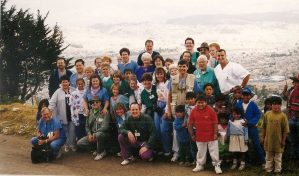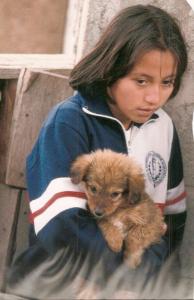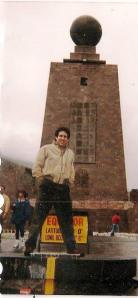When I told my mother that my husband, my daughter and I were bringing drugs into a South American country this alarmed her so much I had to confess it was for a medical mission. Though I knew only first aid and enough Spanish to order food, I volunteered for a medical mission to Quito, Ecuador, with thirty-three others at the invitation of Reverend Tom Rackoczy.
Tom assured me there was plenty for me to do. He explained that part of the mission included basic medical and dental care for the poor just outside the city. I would be asking people to read an eye chart and giving out glasses and shoes. I learned the Spanish alphabet so I could read the eye chart. ‘Outside the city’ turned out to mean 11,000 feet above sea level on the hillside of one of the four active volcanoes that surround Quito. Falling ash, which is like greasy snow, reminded us daily of our tenuous existence in the shadow of these menacing mountains.
It was the summer of 1998 and the economy in Ecuador was in collapse. Their currency known as the sucre, was devalued as banks failed and closed. We were unaware of this problem because we were focused on the medical and dental needs of the poor. Our clinic treated 1257 people from August 8 to the 16th. Of those, 335 were under the age of seven. Every man, woman and child left the clinic with a Bible. Though many live below the poverty line, the literacy rate in Ecuador is in the 90 percent range.
I wrote the following on the last day of the mission.
I NEVER EXPECTED:
- a faucet marked C would give HOT water
- to hear a rooster in a city of 1.8 million
- to see my husband straddling the equator
- my child to ask for five-thousand [sucre] to buy a pack of gum
- my physician husband to learn only one phrase in Spanish, which he never used, “Do you have your insurance card?” He was overjoyed he had no paperwork to file.
- to hear dentist Daron Sheline sing “It’s a wonderful day in the neighborhood” as he stepped into the clinic.
- to see women carrying chickens in their sweaters
- that wire and sheets of black visqueen could serve as exam room walls
- to hear a man read lines of the eye chart as words “DAOF” and “OFLACTA” which made the interpreter giggle
- to watch jets roar by at eye level to our hotel room
- that coffee poured like syrup and served with hot milk would keep us caffeinated all day long
- that we would set aside five million [sucre] for a day’s shopping
- that a warm coca cola would taste so good
- that I would feel so tall in a crowd
- that a lack of cats in the streets meant the street food vendors were stocked up
- that people would get so excited to receive a pair of used glasses or shoes
- that a rooster couldn’t tell the difference between sunrise and streetlights
- that I could fall asleep with the sound of gunfire in the streets below
- that I could be of any help on a medical mission
- that I’d learn new ways to flush a toilet
- that while wearing a coat of dust and vomit stains, I could feel so happy
- that I would learn from a mission how much I can live without.
I appreciate the universal symbols used on restrooms all the more since that experience. At a restaurant I was faced with choosing between two doors for the women’s restroom. Nothing was labeled Damas or Senoritas. Hopping in place, I asked my daughter, “Am I a Caballero?”
She shouted back, “Only if you stand up to pee.”
That mission trip sparked my daughter’s interest in medicine, she is an LPN working for a home health care company and she is working on her BSN. My husband is an orthopedic surgeon. Me? Still just first-aid trained, but glad I volunteered for the trip. Thank you, Reverend Tom Rackoczy, for inviting us.



What an amazing experience. I can’t imagine falling asleep to the sound of gunfire or being afraid to let my cat out of the house. Most people that talk about going on missions say how gracious and kind the citizens were, is that what you found? Were you worried about Gorilla soldiers? BIG spiders? I’d think going to a third world country would leave a lasting impression. We take so much for granted in our cushy lives, clean water and ample food for instance.
Jacquie,
I took many things for granted. Clean water, safety, access to medical care, housing, food. We were in a poor barrio where people farm on the hillsides. No threat of hostage taking here as in Mexico and other countries. The gunfire was in celebration of Saturday, like we shoot off fireworks on the fourth of July. Foolish drunken behavior. The people we met were soft-spoken, gracious and treasure education so much that they sacrifice whatever it takes to put their children in school.
Joni